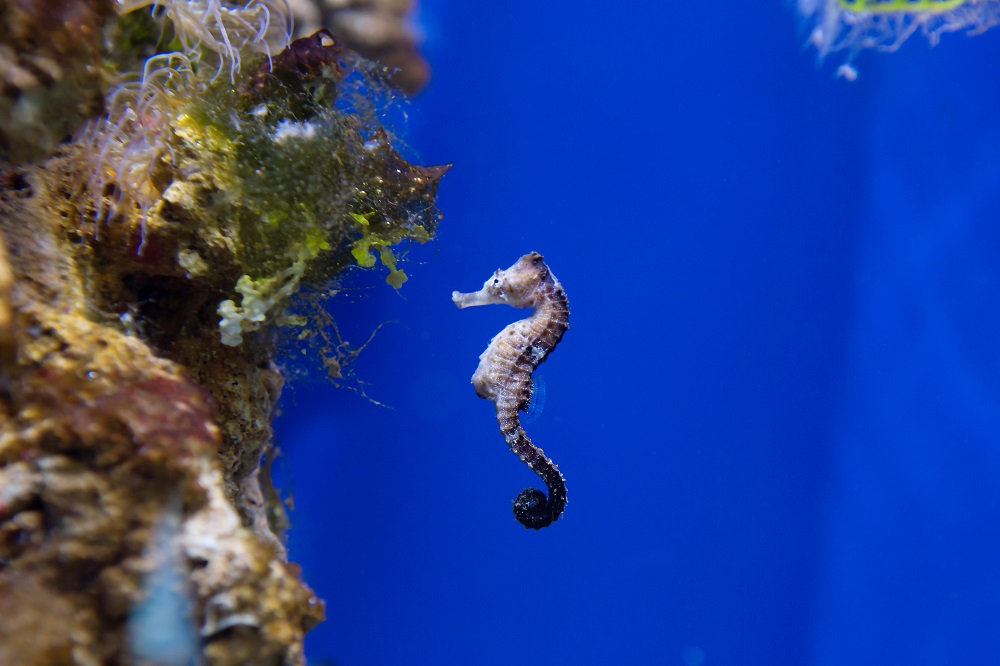Seahorses are often described as the least fish-like fish because of their poor swimming skills, horse-shaped heads and prehensile tails used to grip the seafloor. But this uniqueness from other types of fish makes them fascinating, and scientists still have lots to learn about their habits, behaviours and appearance.
So, if you’re also interested in finding out more about these marine creatures and fancy testing out your artistic abilities with our step-by-step tutorial for drawing an accurate big-bellied seahorse (Hippocampus abdominalis), you’re in the right place!
What will I need?
If you’re looking for a fun, easy and budget-friendly way to spend an afternoon, this activity is perfect. Not only are you likely to already have everything you need at home, but you can even draw these tiny sea creatures over and over again since there are so many species and colour variations you can try out!
You’ll need the following:
- Paper
- Pencil
- Marker pen
- Rubber
- Coloured pens/pencils
- Protractor (optional)
How to draw a seahorse
Ready to draw a seahorse? Here, you can find our easy-to-follow tutorial for drawing a big-bellied seahorse. From learning about their defining characteristic to nailing down the accurate proportions, we’ve covered everything you need below.
Step 1: Starting with the belly of the seahorse, use curved lines to draw a pear-like shape, being sure not to connect the lines at the top. This is where we’ll draw the horse-shaped head later!
Step 2: Next, it’s time to add the characteristic curving tail at the bottom of the body. From the top right side of the tail, you’ll also need to draw a line curving upwards to create a defined belly for the big-bellied seahorse.
Step 3: Draw horizontal curves down the tail for the seahorse’s tail rings, and then draw horizontal curves on the left side of the body for the trunk rings and bony plates.
Step 4: Add a larger dorsal fin above the tail on the left side of the body and a smaller anal fin under the belly on the right side. These are important since they help the seahorse swim and stay afloat!
Step 5: The final step is to add the horse-shaped head, including the characteristic long snout, large eye, pectoral fin and additional spines. We’ve labelled these in the video to help you know what’s what!
Step 6: Once you’ve outlined your big-bellied seahorse, it’s time to colour it in! Their colours range from black to yellow or tanned, while some might have darker markings. Don’t forget to add in the darker spots for the bony plates next to the trunk rings on their backs.
10 fun facts about seahorses!

Now that you have a beautiful big-bellied seahorse drawing to show off, we think it’s about time we shared a few of our favourite facts about seahorses with you! Here are 10 facts and figures all about these fascinating sea creatures.
- More than 45 species of this oddly shaped fish are known to live in waters around the world.
- Seahorses aren’t strong swimmers, so they usually prefer to chill out in calm, shallow waters near seagrass beds, coral reefs and estuaries.
- The scientific name for a seahorse is Hippocampus.
- Seahorses can vary wildly in appearance from spotty to speckled and striped, and their colourings can be shades of yellows and browns or black with different markings.
- These fish are ambush predators who wait to catch their prey off guard, although their diets usually consist of smaller prey like plankton since they lack teeth and stomachs for chewing and storing larger food.
- Seahorses can give birth to hundreds of fully formed babies at the same time and can have thousands of babies in just one year.
- Since their swimming abilities are lacking, they get around by frantically beating their dorsal fins, while the pectoral fins help them steer and maintain stability. This means that they become exhausted quickly, and frankly, we are too just at the thought of all that effort for such little movement!
- All seahorse species have chameleon-like eyes that can move on their own and a hand-like tail that can grip objects.
- Short snouted seahorses (Hippocampus hippocampus) are most commonly found in the North Atlantic shores. Unfortunately, this species is also classified as Near Threatened on the IUCN Red List.
- Although some seahorse species can be as small as 2cm, the big-bellied seahorse is the largest and can grow up to 35cm.
We hope you enjoyed this tutorial alongside learning some of the most exciting facts about seahorses. For a closer look at our short snouted and big-bellied seahorses, check out our Learning Lab and Sunken Shipwreck exhibits here at Bristol Aquarium. For tickets and more information about booking your next fun-filled visit, click here.
